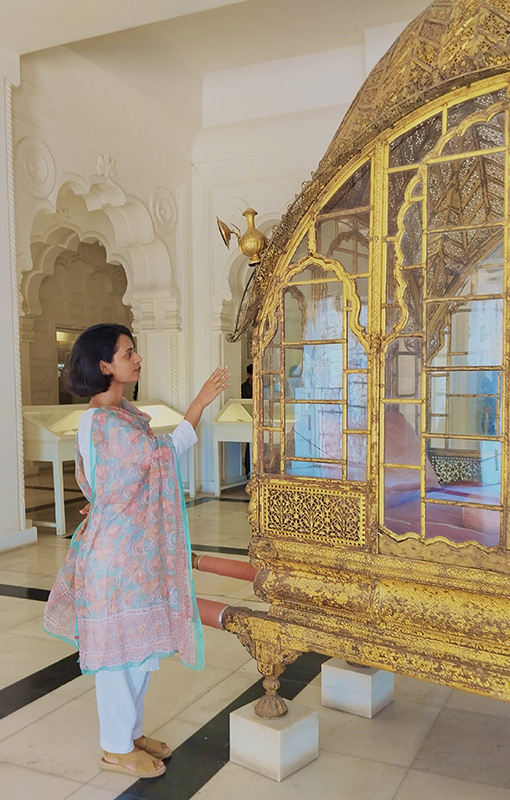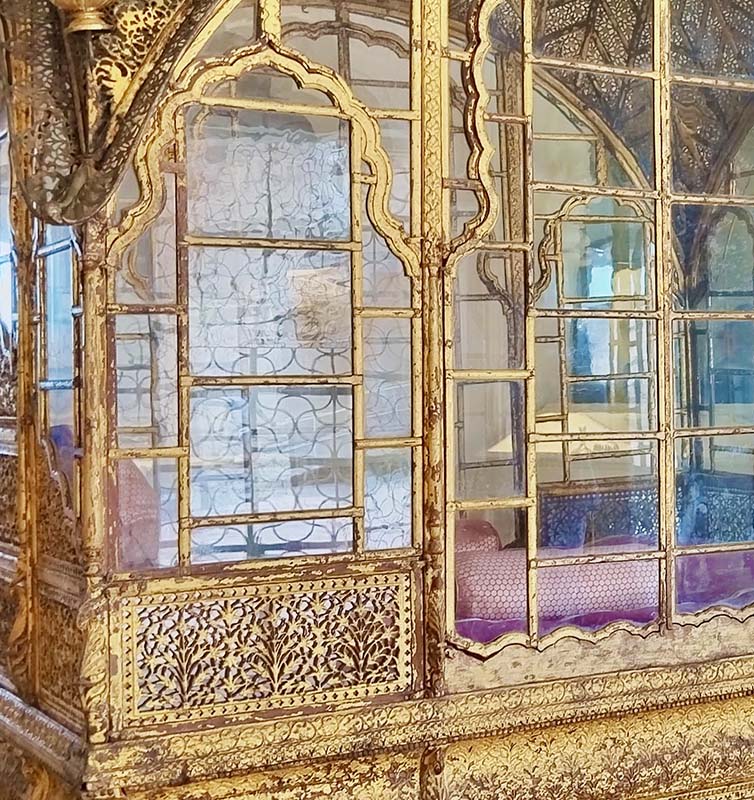The Visual Language of the Mahadol: Examining a Grand Palanquin in India
by Krishna Shekhawat
My dissertation research in the Department of History of Art at the University of California, Berkeley, focuses on early modern South Asian art and architecture, particularly within the Rajput kingdom of Jodhpur-Marwar in present-day Western India. Among the many stunning objects from this kingdom, the object under study here is a glamorous, larger-than-life palanquin, for travel and kingly processional display.
This gilded palanquin made in carved wood and glass is known as the Mahadol or the grand palanquin. The Mahadol was acquired as part of war booty from the battle won by Maharaja Bhai Singh (r. 1724–49) from Gujarat. Currently, this object is displayed in the Daulat Khana gallery at the 15th-century Mehrangarh Fort Museum in India. It is a striking vestige of Mughal-Rajput relations reflecting perspectives on kingship, travel, architecture, patronage, and warfare.
Thanks in part to a Decorative Arts Trust DARTS Research Grant supported by the Decorative Arts Society of Orange County, I was able to travel to India to experience the intricate details of this grand palanquin (figure 1). Studying this object in person brought to light specific perspectives, comparisons, and intersections. These complexities raise pertinent questions about water-tight categorizations of material culture.
The Mahadol, when studied in juxtaposition with textiles, architecture, and the ideals of kingship, presents a world that was interwoven across object categories. The positionality of the Mahadol in the Daulat Khana courtyard (figure 2) is central to its narrative. As one is immersed in the architectural vocabulary of jaalis (lattice-screens) and jharokhas (arched windows), the Mahadol’s architectural inspirations become clear. The dome is crowned with a minuscule shikhara (crown) resembling Bangaldar roof design, which was inspired by the thatched Bengali hut introduced in Western India through Mughal palace architecture. It is decorated with intricate floral patterns that are comparable to the delicate floral motifs on Mughal costumes, such as the textiles designs of the time found in surviving Rajput costumes, such as the angarkha (a men’s flared, long cotton frock, figure 3). These patterns are perforated in a manner similar to the jaalis screens throughout the Fort Museum. Texture played with light and ventilation, both in the Fort architecture as well as this palanquin.
Through such highly visual language, the idea of residence could be retained and communicated to the passenger. For travel, processions, and campaigns, these palanquins provided the familiar comfort of home. It is interesting to note, however, the gendered realities of the object found in its materiality. The transparency of the glass framed by a hierarchy of various jharokhas and windows suggests that it must have been for the ruler (figure 4). Moreover, the sheer scale of the palanquin highlights associations with majestic royalty. It would be carried by 12 palanquin-bearers, who would perhaps have to be of similar height and march to a rhythm to keep the object stable across many shoulders. Even though the materiality of the object and the historical archive associated with the war are available, some questions do remain to be investigated.
As an art historian, I am eager to investigate the nature, location, and craftsmen at the workshop or atelier where such wonders were produced. The tracing of these background processes becomes crucial to a comprehensive understanding of the object. This object has the potential to tell these stories.
Krishna Shekhawat is pursuing a PhD in Art History at University of California, Berkeley.
About The Decorative Arts Trust Bulletin
Formerly known as the "blog,” the Bulletin features new research and scholarship, travelogues, book reviews, and museum and gallery exhibitions. The Bulletin complements The Magazine of the Decorative Arts Trust, our biannual members publication.
Click Images to Enlarge
Did you know that clicking on the images in Bulletin posts will allow you to get a closer look? Simply click on an image, and a larger version will open in a pop-up window.











